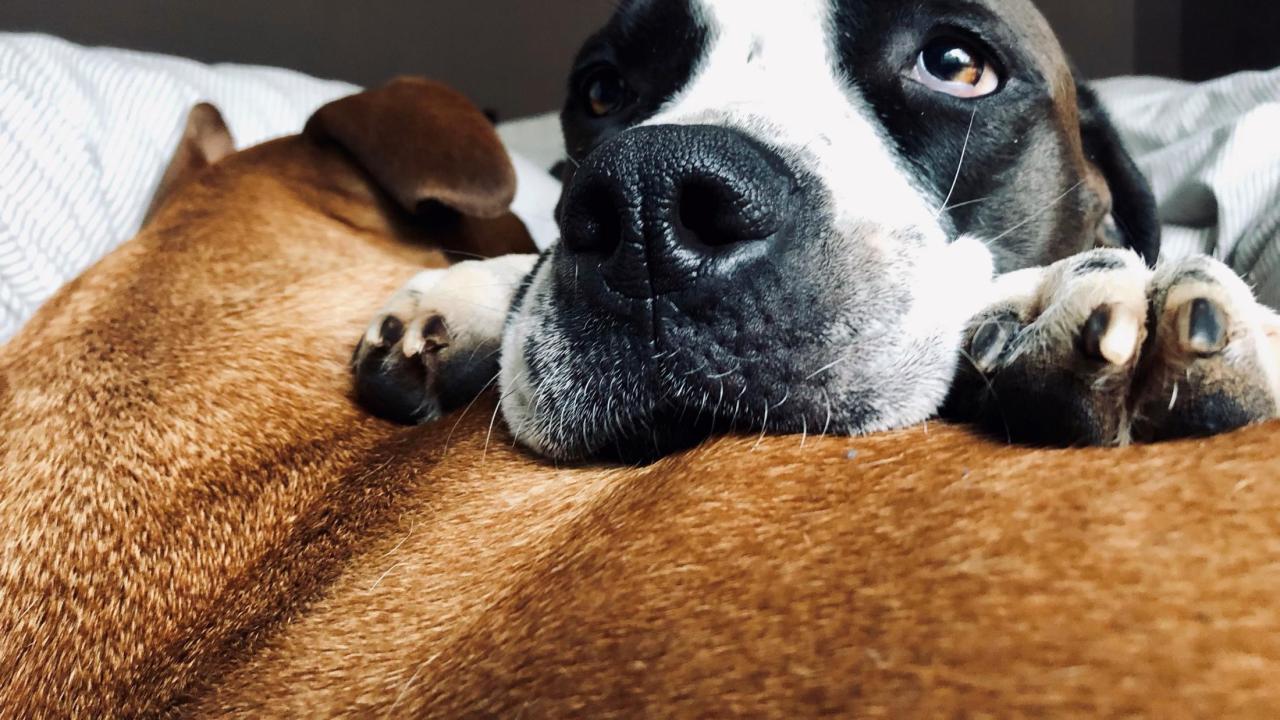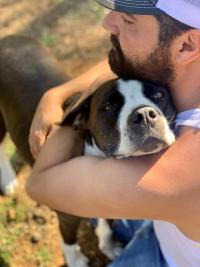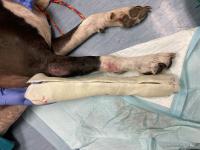
Suspected Bear Attack Leads to Dog’s Long Recovery
“Case of the Month” – February 2022
Seek, a 6-year-old female mastiff, was let out in the early morning on her family’s large property in the Sierra Nevada foothills. A few hours later, she and her brother were found bloodied, with Seek taking the brunt of the injuries – a severely broken leg and facial/oral wounds. A bear attack was suspected.

Owners Anna and Kai Dodds rushed Seek to the local veterinary clinic. Being a general practitioner and lacking the specialty expertise needed to save the leg, their veterinarian suggested getting Seek to the UC Davis veterinary hospital immediately.
Following an initial evaluation by the Emergency/Critical Care Service, Seek’s case was quickly transferred to the Dentistry and Oral Surgery Service and the Orthopedic Surgery Service for specialty care.
Faculty surgeon Dr. Amy Kapatkin and surgery resident Dr. Jessica Smith observed an open bite wound resulting in various broken fragments of the radius and ulna of Seek’s right front limb. Surgical stabilization of the fracture was accomplished with the placement of an external skeletal fixator (ESF), which uses connecting bars and pins to stabilize the bones from the outside. The surgery, closely monitored by specialists from the Anesthesia Service, went well with no intraoperative complications. Post-operative x-rays performed by the Diagnostic Imaging Service showed adequate fracture reduction and appropriate implant placement.
The following day, Seek was seen by oral and maxillofacial surgeon Dr. Boaz Arzi and dentistry and oral surgery resident Dr. Shirley Kot to address her dental and maxillofacial wounds, known as a traumatic dentoalveolar injury (TDI). A CT scan showed her upper left and right canine teeth had been pushed into her nasal cavity. This injury is extremely rare and is generally caused by facial trauma such as an animal fight, car accident, or dramatic fall. This intrusive luxation of the teeth only happens in approximately 0.2% of all TDIs. Both canine teeth were successfully removed along with a fractured molar tooth. Seek was eating well shortly after the surgery. (This dentoalveolar trauma aspect of Seek’s case, and the use of advanced diagnostic imaging to help guide that care, was recently highlighted in the Journal of the American Veterinary Medical Association.)
The ESF on Seek’s leg, utilized due to an infection of the bite wound, needed to stay in place for several months and her activity kept to a minimum. X-rays in the first few months of recovery showed some progression of healing but with slow progress.
After 4 months, x-rays continued to show slow progression of healing, which was not fully unexpected given that the bite wound caused damage to the blood supply and the fracture was so fragmented. At this point, Dr. Kapatkin removed the ESF and suggested that the Dodds consider additional surgical options.

“It was delayed enough to call it a nonunion at that point, meaning the standard protocol of care did not properly heal the break,” Dr. Kapatkin recalled. “All but two pins of the ESF were extremely loose and not doing any work. On palpation, the leg felt stable, but we knew that once she bears weight, the leg will likely fracture again because it is not completely healed.”
Further surgery was recommended, but due to financial and other concerns, a cast-like splint was placed on Seek’s leg until she was fitted with a custom orthotic 5 months after the initial injury.
Recheck examinations after 6 and 8 months showed better healing of the wound than in previous months, and the Dodds reported Seek doing well at home and utilizing the orthotic to slowly increase walks, however controlled and short they were.
Now nearly a year after the attack, Anna Dodds reports that Seek’s leg seems to be fully healed.
“She is back to her old self,” said Dodds. “She’s happy running around, jumping and playing.”
# # #
